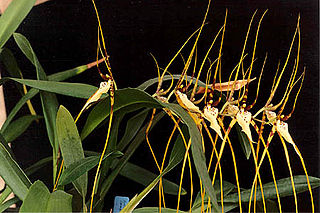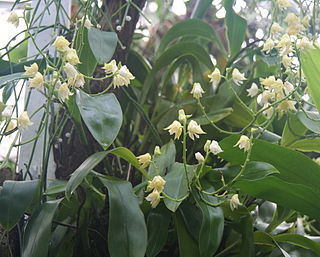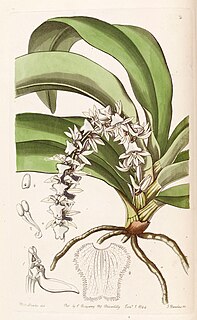
Phragmipedium is a genus of the Orchid family (Orchidaceae) and the only genus comprised in the tribe Phragmipedieae and subtribe Phragmipediinae. The name of the genus is derived from the Greek phragma, which means "division", and pedium, which means "slipper". It is abbreviated 'Phrag' in trade journals.

Brassia is a genus of orchids classified in the subtribe Oncidiinae. It is native to Mexico, Central America, the West Indies, and northern South America, with one species extending into Florida.

Coelogyne is a genus of over 200 sympodial epiphytes from the family Orchidaceae, distributed across India, China, Indonesia and the Fiji islands, with the main centers in Borneo, Sumatra and the Himalayas. They can be found from tropical lowland forests to montane rainforests. A few species grow as terrestrials or even as lithophytes in open, humid habitats. The genera BolborchisLindl., HologynePfitzer and PtychogynePfitzer are generally included here. The genus is abbreviated Coel. in trade journals.

Laeliinae is a Neotropical subtribe including 40 orchid genera, such as Brassavola, Laelia and Cattleya. The genus Epidendrum is the largest within this subtribe, containing about 1500 species. This is followed by the genus Encyclia, with over 120 species.

Holothrix is a genus of plants in family Orchidaceae. It contains the following species :

Polystachya, abbreviated Pol in horticultural trade, and commonly known as yellowspike orchid, is a flowering plant genus in the orchid family (Orchidaceae). This rather distinctive genus was described by William Jackson Hooker in 1824 and is the type genus of the subtribe Polystachyinae. It contains about 100 species widespread across many of the tropical areas of the world.

Orthochilus is a genus of orchids that consists of at least 34 species, most of which are native to Africa and Madagascar with a few species in tropical and subtropical America. The genus was first formally described in 1850 by the French botanist Achille Richard, who cited an earlier suggestion by the German botanist Christian Ferdinand Friedrich Hochstetter. Richard recognized a single species, Orthochilus abyssinicus, and noted that the genus shared many features with the closely related genus Eulophia, but differed from it in the form of the pollen masses and caudicule, a stalk to which the pollen masses are attached. The genus Orthochilus has often been viewed as a synonym of the larger genus Eulophia by many botanists, but a recent molecular phylogeny published in 2014 revealed that Eulophia, as traditionally circumscribed, was paraphyletic unless Orthochilus was recognized as a separate genus.

Jumellea is an orchid genus with around 40 species native to Madagascar, the Comoros, the Mascarenes, and eastern Africa. In horticulture, it is often abbreviated Jum. It is named after H. L. Jumelle, a French botanist.

Trichoglottis, commonly known as cherub orchids or 毛舌兰属 , is a genus of flowering plants in the family Orchidaceae. Orchids in this genus are epiphytic plants with thick roots, relatively thick, fibrous stems and many large, thick, leathery leaves arranged in two ranks. The flowers are usually small and yellowish with light brown or purple markings. The flowers have broad sepals, narrower petals and a labellum which has three lobes and is often hairy. There are about 85 species distributed from tropical and subtropical Asia to the north-western Pacific. Most species grow in rainforest.

Ancistrorhynchus is a genus of flowering plants from the orchid family Orchidaceae. It contains 16 species native to tropical Africa.

Diaphananthe is a genus of flowering plants from the orchid family, Orchidaceae. As currently conceived, it contains 33 accepted species, all endemic to sub-Saharan Africa
- Diaphananthe arbonnieriGeerinck
- Diaphananthe bidens(Afzel. ex Sw.) Schltr.
- Diaphananthe bueae(Schltr.) Schltr.
- Diaphananthe cerifloraJ.B.Petersen
- Diaphananthe delepierreanaJ.-P.Lebel & Geerinck
- Diaphananthe divitiflora(Kraenzl.) Schltr.
- Diaphananthe dorotheae(Rendle) Summerh.
- Diaphananthe eggelingiiP.J.Cribb
- Diaphananthe fragrantissima(Rchb.f.) Schltr.
- Diaphananthe gabonensis(Summerh.) P.J.Cribb & Carlsward
- Diaphananthe garayanaSzlach. & Olszewski
- Diaphananthe ichneumonea(Lindl.) P.J.Cribb & Carlsward
- Diaphananthe lanceolata(Summerh.) P.J.Cribb & Carlsward
- Diaphananthe lecomtei(Finet) P.J.Cribb & Carlsward
- Diaphananthe letouzeyi(Szlach. & Olszewski) P.J.Cribb & Carlsward
- Diaphananthe lorifoliaSummerh.
- Diaphananthe millarii(Bolus) H.P.Linder
- Diaphananthe odoratissima(Rchb.f.) P.J.Cribb & Carlsward
- Diaphananthe pellucida(Lindl.) Schltr.
- Diaphananthe plehniana(Schltr.) Schltr.
- Diaphananthe rohrii(Rchb.f.) Summerh.
- Diaphananthe sanfordianaSzlach. & Olszewski
- Diaphananthe sarcophylla(Schltr. ex Prain) P.J.Cribb & Carlsward
- Diaphananthe sarcorhynchoidesJ.B.Hall
- Diaphananthe spiralis(Stévart & Droissart) P.J.Cribb & Carlsward
- Diaphananthe subclavata(Rolfe) Schltr.
- Diaphananthe suborbicularisSummerh.
- Diaphananthe thomensis(Rolfe) P.J.Cribb & Carlsward
- Diaphananthe trigonopetalaSchltr.
- Diaphananthe vagans (Lindl.) P.J.Cribb & Carlsward
- Diaphananthe vandiformis(Kraenzl.) Schltr.
- Diaphananthe vesicata(Lindl.) P.J.Cribb & Carlsward
- Diaphananthe welwitschii(Rchb.f.) Schltr

Elleanthus is a genus of flowering plants from the orchid family, Orchidaceae. All the species are native to the warmer parts of the Western Hemisphere.

Fernandezia is a genus of flowering plants from the orchid family, Orchidaceae. It contains about 30-40 species, native to northern South America, Central America, and southern Mexico.

Gomphichis is a genus of flowering plants from the orchid family, Orchidaceae, native to Costa Rica and northern South America.
Tridactyle is a genus of flowering plants from the orchid family, Orchidaceae. It has about 60-70 known species, all native to sub-Saharan Africa.
Platylepis is a genus of flowering plants from the orchid family, Orchidaceae. It is widespread across sub-Saharan Africa and also on various islands of the Pacific and Indian Oceans.
- Platylepis bigibbosaH.Perrier - Madagascar
- Platylepis bombusJ.J.Sm. - Seram
- Platylepis commelynae(Lindl.) Rchb.f. - Society Islands
- Platylepis constricta(J.J.Sm.) J.J.Sm. - New Guinea
- Platylepis densifloraRolfe - Réunion
- Platylepis geluana(Schltr.) Schuit. & de Vogel - New Guinea
- Platylepis glandulosa(Lindl.) Rchb.f. - widespread across tropical and southern Africa
- Platylepis grandiflora(Schltr.) Ormerod - New Caledonia, Vanuatu, Futuna
- Platylepis heteromorphaRchb.f. - Samoa
- Platylepis intricataSchuit. & de Vogel - Papua New Guinea
- Platylepis lamellataSchltr. - New Guinea
- Platylepis margaritiferaSchltr. - Madagascar
- Platylepis occulta(Thouars) Rchb.f. - Madagascar, Réunion, Mauritius, Seychelles
- Platylepis polyadeniaRchb.f. - Madagascar, Comoros
- Platylepis rufa(Frapp.) Schltr. - Réunion
- Platylepis tidorensisJ.J.Sm. - Maluku
- Platylepis viscosa(Rchb.f.) Schltr. - Réunion
- Platylepis xerosteleOrmerod - Cameroon
- Platylepis zeuxinoidesSchltr. - New Guinea
Oeceoclades beravensis is a terrestrial orchid species in the genus Oeceoclades that is endemic to the southern and western Madagascar where it grows in the sandy soils of western dry forests and wooded grasslands. This species has cane-like stems and forms dense clumps in the understorey, a feature that makes it unique among the Eulophiinae species found in Madagascar. Like other orchid species in Eulophia and Oeceoclades that are adapted to arid climates, O. beravensis has narrow and coriaceous leaves with minute serrations.

















